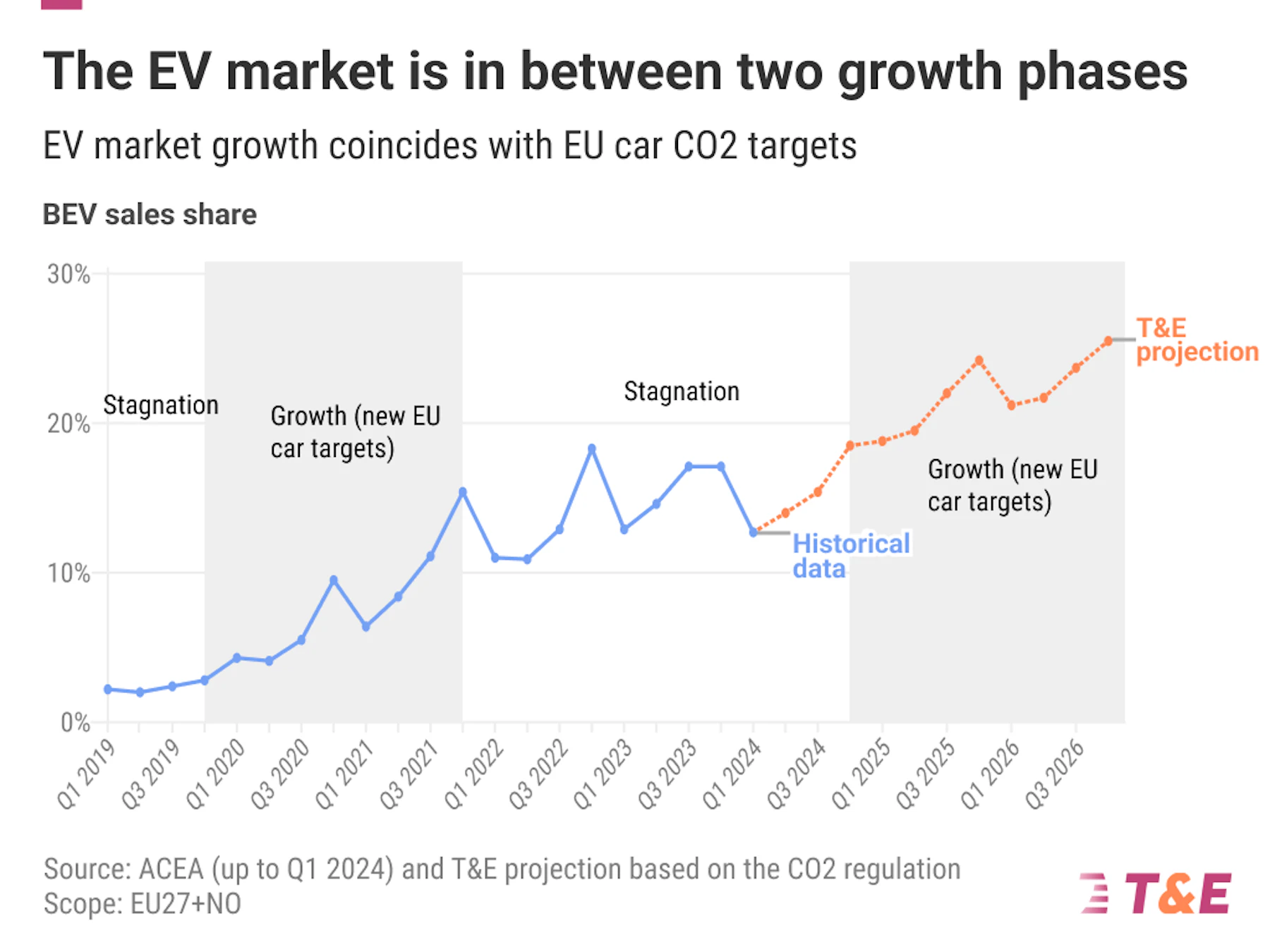Join each day information updates from CleanTechnica on e-mail. Or comply with us on Google Information!
A T&E briefing outlines why the 2035 aim is so essential and why the EU shouldn’t reverse it.
1. Why is it essential for the local weather, the economic system and jobs in Europe?
Sustaining the ambition of the EU automobile CO2 requirements, together with the 2035 100% zero emission goal is essential for offering carmakers and the emobility worth chain with the regulatory certainty wanted to securely spend money on electrical automobile, battery manufacturing and charging infrastructure in Europe. In September 2024, 50 CEOs and executives known as on the brand new EU Fee and MEPs to “maintain the 100% zero-emission car target in 2035”.
The automobile CO2 regulation has been the primary driver of funding within the EV worth chain in Europe. With the introduction of the EU automobile CO2 targets in 2020, EV investments in Europe elevated by an element of 20 (from €3.2 bn to €60 bn). Greater than 50 European gigafactories are deliberate to provide battery cells by 2030, requiring greater than €170 billion in investments, enough to energy all new automobile gross sales within the EU from 2026.
With uncertainty over its 2035 zero-emission automobile goal and a weak industrial coverage, Europe is proving much less enticing to electrical automobile producers. Whereas €70 billion of EV funding by carmakers has been introduced for Europe between 2021 and 2023, North America, attracted €97 billion over the identical interval. Any weakening of the targets will additional scale back the attractiveness of Europe as an funding vacation spot.
A examine by BCG analysed the influence of a shift to EVs on jobs within the automotive sector and confirmed that jobs misplaced within the conventional fossil-fuel focussed industries could be offset by new jobs within the quick rising e-mobility worth chain.
Local weather
Reaching local weather neutrality by 2050 requires the EU to get rid of fossil fuels, particularly from the transport sector, which accounts for 29% of EU emissions. Mild obligation autos (automobiles and vans) are chargeable for round half of those emissions. EVs emit considerably much less CO2 over their lifecycle in comparison with petrol or diesel automobiles, making them important in combating local weather change.
Automotive CO2 regulation: how does it work?
The automobile CO2 regulation units legally binding targets for common CO2 emissions from new automobiles offered by carmakers yearly. The regulation operates in five-year steps, creating an inevitable acceleration-stagnation momentum. The identical targets apply from 2021 to 2024, with the following targets being a 15% discount in 2025 (versus 2021), a 55% discount in 2030, and a 100% discount by 2035. Till now these targets have been met by nearly all carmakers and the identical is anticipated for future targets. Technological developments and compliance choices, equivalent to pooling with different carmakers, CO2 bonus for promoting a sure variety of EVs, and utilizing eco-credits, help this compliance. The regulation accommodates a clause to overview the regulation in 2026.
=
2. The 2035 100% zero emission automobile goal is possible
A Bloomberg examine reveals that reaching 100% electrical automobiles and vans in 2035 is possible. Battery electrical automobiles will probably be cheaper to purchase in Europe than fossil-fuel autos by 2028 on the newest. In lots of instances this may come earlier as carmakers have introduced a dozen inexpensive, sub-€25,000 Made-in-Europe EV fashions for 2024-2027. Mixed with a lot decrease working prices, the EV transition is certain to be irreversible.
Reaching local weather neutrality by 2050 requires the EU to get rid of fossil fuels, particularly from the transport sector, which accounts for 29% of EU emissions. Mild obligation autos (automobiles and vans) are chargeable for round half of those emissions. EVs emit considerably much less CO2 over their lifecycle in comparison with petrol or diesel automobiles, making them important in combating local weather change.
The automobile CO2 regulation units legally binding targets for common CO2 emissions from new automobiles offered by carmakers yearly. The regulation operates in five-year steps, creating an inevitable acceleration-stagnation momentum. The identical targets apply from 2021 to 2024, with the following targets being a 15% discount in 2025 (versus 2021), a 55% discount in 2030, and a 100% discount by 2035. Till now these targets have been met by nearly all carmakers and the identical is anticipated for future targets. Technological developments and compliance choices, equivalent to pooling with different carmakers, CO2 bonus for promoting a sure variety of EVs, and utilizing eco-credits, help this compliance. The regulation accommodates a clause to overview the regulation in 2026.
As well as, binding EU regulation mandates that the EU’s most important highways and roads be coated with quick chargers from 2025, and that the variety of chargers general improve according to the uptake of electrical autos in every member state.
Most automobile firms, together with Volkswagen have been in help of the 2035 goal as they want funding certainty. Essentially, the query of feasibility is just not a matter of technical feasibility however fairly a matter of political willingness and dedication to current local weather and industrial insurance policies.
3. What is required for the brand new EU legislative time period
First, European carmakers and politicians have to be firmly dedicated to the 2035 goal and to speed up the ramp up of electrical automobile fashions, particularly the extra inexpensive ones. Specifically, the EU shouldn’t get sidetracked by polluting, inefficient and costly artificial fuels (or e-fuels) and biofuels.
Second, the brand new EU Fee ought to help an bold industrial technique to speed up and scale up the European e-mobility worth chain, with a give attention to attracting funding to Europe, R&D clear native manufacturing, and upskilling of native staff.
Courtesy of Transport & Setting.